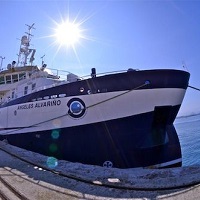Keyword
Particulate inorganic carbon concentrations in the water column
2 record(s)
Type of resources
Categories
Topics
INSPIRE themes
Keywords
Contact for the resource
Provided by
Years
Formats
Status
-

Background and Aims MEDWAVES The Strait of Gibraltar (SG) and the surrounding areas, Gulf of Cadiz (GoC) in the Atlantic, and Alboran sea (AS) in the Mediterranean, are key areas to understand the distribution and connectivity of marine communities (Patarnello et al. 2007), as the SG and the encounter of water masses at the Almeria Oran front represent an oceanographic transition area, connecting the Atlantic Ocean and the Mediterranean Sea (Lacombe & Richez 1982). The Mediterranean water flows out from Gibraltar (MOW), extends towards the East of the Atlantic, building a warm and salty water mass which propagates in North West direction from Portugal originating the “Mediterranean Water“ (MW) in the Atlantic. This warm and salty water mass becomes characteristic of the North Atlantic in mid waters (around 1100 m) (Candela 2001). The occurrence of cold-water coral (CWC) communities in the NE Atlantic has been related to the pathway of the MOW, whereby this current system would have an historical influence on the migration of coral larvae and (re)colonization of the Atlantic in the post-glacial era (De Mol et al. 2005, Henry et al. 2014). The MEDWAVES (MEDiterranean out flow WAter and Vulnerable EcosystemS) cruise target areas under the potential influence of the MOW within the Mediterranean and Atlantic realms. These include seamounts where CWC have been reported but that are still poorly known, and which may act as essential “stepping stones” connecting fauna of seamounts in the Mediterranean with those of the continental shelf of Portugal, the Azores and the Mid-Atlantic Ridge. During MEDWAVES sampling will be conducted through two of the case studies of ATLAS: Case study 7 (Gulf of Cadiz-Strait of Gibraltar-Alboran Sea) and Case study 8 (Azores). The main goals of the cruise are: (1) to characterize physically and biogeochemically the MOW Path and understand its interaction with the general Atlantic Meridional Overturning Circulation (AMOC) stream, from the Alboran Sea to the Azores, through the Gulf of Cadiz, and the Ormonde Seamount (see map), exploring the relationship between the oceanographic settings of these target areas and the ecosystems therein (ATLAS WP1 and WP3) and (2) to characterize communities associated to the transition area, and sample for population genetic analysis aiming at understanding the way the populations located in the target areas contribute or have contributed to connectivity between the Mediterranean Sea and the Atlantic Ocean (ATLAS WP3 and WP4). Results gathered during the cruise will also contribute later to feed other ATLAS WPs. The activities planned to achieve these aims are presented in the brief description of the work program of the different research teams participating in ATLAS (Work program of the research teams).
-

The main objectives for the MedSeA cruise are to: - Refine climatological maps of carbonate species distribution (pH, pCO2, CO32-, CT, AT, CaCO3 saturation states), along with their isotopic signatures, in the Mediterranean Sea. - Report on the determination of the anthropogenic carbon distribution throughout the whole Mediterranean Sea and its associated uncertainty estimate - Determine the effects of carbonate chemistry on Mediterranean calcifying and non-calcifying planktonic organisms. - Determine synergistic effects of acidification, warming and nutrients on key pelagic organisms. - Identify and quantify responses of fundamental Mediterranean biogeochemical processes to acidification and warming. - MedSeA is carried out in collaboration with the Geotraces program in order to collect water for chemical large volume trace elements and isotopes such as Th/Pa, Artificial radionuclides, Th-234, Nd-isotopes and Ra.
 Catálogo de datos del IEO
Catálogo de datos del IEO